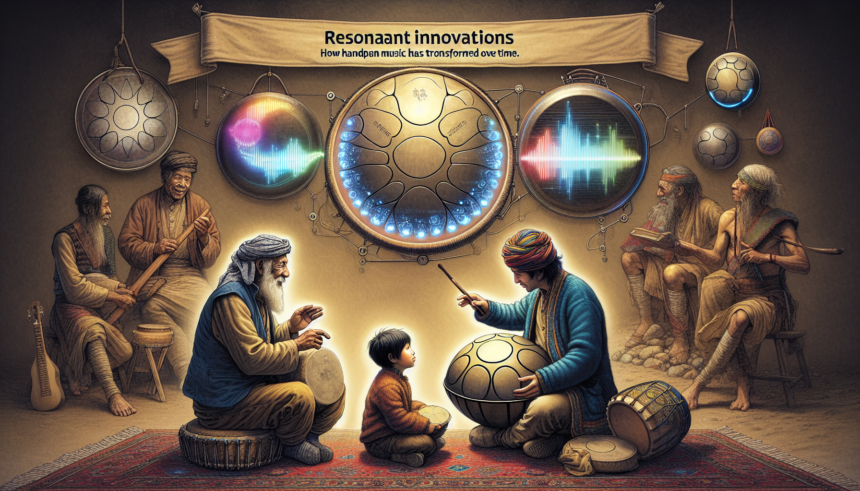When Felix Rohner and Sabina Schärer introduced the Hang — a novel musical instrument with a unique, ethereal sound — in 2000, it captured the imagination of musicians and listeners alike. Little did anyone know that what started as an exploratory project would ultimately give rise to the diverse and dynamic world of handpan music.
The Genesis of the Handpan
The Hang, produced by PANArt, was more than a percussion instrument; it was an auditory sculpture, resonant and expressive. Unlike traditional instruments, the Hang’s design prioritized both the harmonics and the tactile experience of the musician. Its captivating, resonant soundscapes drew from influences as varied as Trinidad steelpans and Indonesian gamelan.
PANArt eventually ceased Hang production in 2013, choosing to focus on different projects. However, the groundwork had been laid, and numerous other individuals and companies began producing similar instruments, broadly classified under the term “handpan.” This extended family of instruments has since expanded in both range and resonance.
From Hang to Handpan: The Growing Family
The termination of PANArt’s Hang manufacturing opened the floodgates for innovation. Various makers adopted and adapted the handpan’s design, materials, and tuning structures. Each brought unique elements to the original blueprint, contributing to a broader landscape of sonorous possibilities.
Material Innovations
Initially, handpans were primarily made from nitrided steel, which offered resistance to rust and provided a unique timbre. As knowledge grew, so did the diversity of materials. Some handpans today are made from stainless steel, offering a brighter tone and longer sustain, ideal for meditative and ambient music.
Tuning and Variations
Early handpans had fewer scale options, often limiting musicians to one mode or key per instrument. Modern handpans, however, now explore exotic scales and micro-tunings. Makers are more adept at refining the craft, and as a result, offer custom scales to fit various musical traditions, from Arabic Maqam to Indian Raga, allowing the instrument to transcend cultural and musical boundaries.
Enhanced Ergonomics and Playability
Another area of innovation is the design and ergonomics of the handpan. Modern instruments are crafted to be more versatile and ergonomic, making them accessible to a broader range of musicians. The instruments are lighter and more portable while still retaining their complex acoustics.
The Influence of Technology
Today’s handpan music scene is deeply intertwined with technology. The internet has turned the handpan into a global phenomenon, and digital tools have significantly impacted how these instruments are made, learned, and appreciated.
Social Media and Sharing
Platforms like YouTube, Instagram, and Facebook have allowed musicians to share their performances and techniques with a global audience. This interconnectedness has accelerated the learning curve for new players and allowed for the rapid dissemination of new styles and techniques.
Digital Tuning
Modern handpan makers employ sophisticated software to assess and fine-tune the instruments. Digital tuners can measure minute changes in frequency, helping to create more precise and harmonically rich instruments.
Handpan Music: An Evolving Genre
The evolution of the handpan has gone hand-in-hand with the diversification of its musical context. Initially primarily used for solo, contemplative performances, handpans are now found in an array of musical genres.
Fusion with Other Genres
One of the most exciting developments in handpan music is its integration with other musical styles. Handpans are increasingly found in jazz ensembles, electronic music, and even rock bands. This fusion of genres has helped to diversify the instrument’s audience and broaden its creative potential.
Collaborative Projects
Handpan artists often collaborate with musicians from other disciplines. These collaborations have resulted in innovative performances that blend Western and non-Western musical traditions. The handpan’s versatility lends itself to a wide array of collaborative projects, contributing to a rich and varied global music scene.
Educational Horizons
Handpan education has also evolved significantly. Earlier, learning was restricted to physical workshops or apprenticeship under an experienced player. Today, a myriad of online courses and tutorials allow anyone with an internet connection to delve into the magic of handpan music.
Online Tutorials and Courses
Numerous websites and platforms offer both free and paid courses in handpan playing. Covering a range of techniques from basic rhythm to advanced melodic patterns, these resources make learning accessible to a wider audience.
Community and Forums
Online communities play a significant role in the learning experience. Platforms like Facebook groups, Reddit threads, and specialized forums provide a space for players to share tips, discuss techniques, and even trade instruments. This sense of community fosters not just skill development but also a deeper appreciation of the art form.
Workshops and Retreats
Despite the convenience of online learning, in-person workshops and retreats remain popular. These gatherings offer immersive experiences where learners can engage with experienced players, participate in live jams, and gain real-time feedback. These face-to-face interactions often go beyond technical skill, helping participants understand the emotional and spiritual dimensions of handpan music.
The Future of Handpan Music
The future of handpan music looks bright and full of potential. As more musicians and inventors enter the field, we can expect further innovation in design, material, and technique. Additionally, as the instrument integrates more deeply into various musical traditions, it will continue to evolve, offering new and unexplored avenues for expression.
Technological Advancements
Emerging technologies like artificial intelligence and machine learning could significantly impact handpan making and playing. AI can provide instant feedback to players, while machine learning algorithms could aid in crafting more precise instruments.
Cultural Integration
The handpan is likely to fuse even more deeply with diverse musical traditions around the world. As musicians from different cultural backgrounds experiment with the instrument, they will undoubtedly bring fresh perspectives and innovations, enriching the global music tapestry.
Increased Accessibility
Efforts to make handpans more affordable will continue, making them accessible to a broader demographic. Some makers are even exploring cost-effective materials and automated processes to bring down production costs, thus broadening the instrument’s reach.
Conclusion
The journey of the handpan from a niche instrument to a global phenomenon is a testament to human creativity and innovation. From the pioneering work of PANArt to the myriad variations and technological advancements today, handpan music has come a long way. The instrument’s evolving nature ensures its place in the world of music for years to come, as musicians and makers continue to explore its limitless possibilities. Through the fusion of tradition and modernity, the handpan will undoubtedly continue to enchant audiences worldwide.
FAQs
1. What is the difference between a Handpan and a Hang?
While “Hang” specifically refers to the instrument created by PANArt, “handpan” is a broader term used to describe similar steel instruments made by other manufacturers. After PANArt ceased the production of the Hang, the term “handpan” became commonly used to describe these instruments.
2. How is a handpan different from a steelpan?
Although both are made from steel, a handpan and a steelpan are different in design, sound, and playability. A steelpan typically originates from Trinidad & Tobago and is played with sticks, producing a bright, sharp sound. The handpan, however, is played with the hands, producing a softer, more resonant tone.
3. Are all handpans made from the same material?
No, handpans can be made from various types of steel, including nitrided steel, stainless steel, and some other custom alloys. Each material has its own unique effect on the instrument’s sound and durability.
4. Can a handpan be tuned to different scales?
Yes, modern handpan makers often create instruments in various scales, tailored to fit different musical needs. These can range from traditional Western scales to more exotic or culturally specific tunings.
5. Is it difficult to learn the handpan?
Learning to play the handpan can vary in difficulty depending on your musical background and the time you invest in practice. However, with numerous online tutorials, communities, and courses available, it has become easier than ever to learn the basics and progress to advanced techniques.





